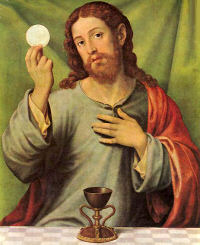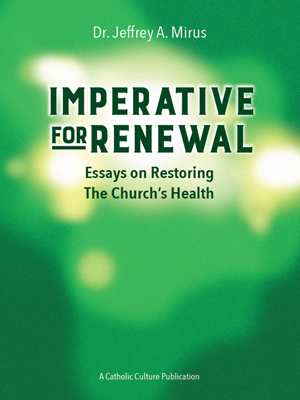Ordinary Time: June 10th
Solemnity of the Most Holy Body and Blood of Christ:
Other Titles: Corpus Christi
» Enjoy our Liturgical Seasons series of e-books!
This Feast invites us to contemplate the supreme Master of our faith: the Blessed Eucharist, the real presence of the Lord Jesus Christ in the Sacrament of the altar.... Every time that the priest renews the Eucharistic Sacrifice, in the prayer of consecration he repeats: "This is my Body... this is my Blood". He says this lending his voice, hands and heart to Christ, who wanted to stay with us and be the heartbeat of the Church.
Indeed, an intrinsic connection exists between celebration and adoration. In fact, Holy Mass is in itself the Church's greatest act of adoration: "No one eats of this flesh", as St Augustine writes, "without having first adored it" (Enarr. in Ps. 98,9: CCL XXXIX, 1385).
Adoration outside Holy Mass prolongs and intensifies what has taken place in the liturgical celebration and makes a true and profound reception of Christ possible.
Today, then, the Eucharistic procession is taking place in Christian communities in all parts of the world. It is a special form of public adoration of the Eucharist, enriched by beautiful and traditional expressions of popular devotion. I would like to take the opportunity offered to me by today's Solemnity to warmly recommend, to Pastors and to all the faithful, the practice of Eucharistic adoration.
In life today, often noisy and dispersive, it is more important than ever to recover the capacity for inner silence and recollection. Eucharistic adoration permits this not only centred on the "I" but more so in the company of that "You" full of love who is Jesus Christ, "the God who is near to us".
— Excepted from Benedict XVI Address of June 10, 2007
Where the Solemnity of the Body and Blood of Christ is not observed as a holy day, it is assigned to the Sunday after Trinity Sunday, which is then considered its proper day in the calendar.
Corpus Christi Sunday
Corpus Christi (Body and Blood of Christ) is a Eucharistic solemnity, or better, the solemn commemoration of the institution of that sacrament. It is, moreover, the Church's official act of homage and gratitude to Christ, who by instituting the Holy Eucharist gave to the Church her greatest treasure. Holy Thursday, assuredly, marks the anniversary of the institution, but the commemoration of the Lord's passion that very night suppresses the rejoicing proper to the occasion. Today's observance, therefore, accents the joyous aspect of Holy Thursday.
The Mass and the Office for the feast was edited or composed by St. Thomas Aquinas upon the request of Pope Urban IV in the year 1264. It is unquestionably a classic piece of liturgical work, wholly in accord with the best liturgical traditions. . . It is a perfect work of art.
—Excerpted from The Church's Year of Grace, Pius Parsch
In the words of St. Thomas:
"How inestimable a dignity, beloved brethren, divine bounty has bestowed upon us Christians from the treasury of its infinite goodness! For there neither is nor ever has been a people to whom the gods were so nigh as our Lord and God is nigh unto us.
"Desirous that we be made partakers of His divinity, the only-begotten Son of God has taken to Himself our nature so that having become man, He would be enabled to make men gods. Whatever He assumed of our nature He wrought unto our salvation. For on the altar of the Cross He immolated to the Father His own Body as victim for our reconciliation and shed His blood both for our ransom and for our regeneration. Moreover, in order that a remembrance of so great benefits may always be with us, He has left us His Body as food and His Blood as drink under appearances of bread and wine.
"O banquet most precious! O banquet most admirable! O banquet overflowing with every spiritual delicacy! Can anything be more excellent than this repast, in which not the flesh of goats and heifers, as of old, but Christ the true God is given us for nourishment? What more wondrous than this holy sacrament! In it bread and wine are changed substantially, and under the appearance of a little bread and wine is had Christ Jesus, God and perfect Man. In this sacrament sins are purged away, virtues are increased, the soul is satiated with an abundance of every spiritual gift. No other sacrament is so beneficial. Since it was instituted unto the salvation of all, it is offered by Holy Church for the living and for the dead, that all may share in its treasures.
"My dearly beloved, is it not beyond human power to express the ineffable delicacy of this sacrament in which spiritual sweetness is tasted in its very source, in which is brought to mind the remembrance of that all-excelling charity which Christ showed in His sacred passion? Surely it was to impress more profoundly upon the hearts of the faithful the immensity of this charity that our loving Savior instituted this sacrament at the last supper when, having celebrated the Pasch with His disciples. He was about to leave the world and return to the Father. It was to serve as an unending remembrance of His passion, as the fulfillment of ancient types — this the greatest of His miracles. To those who sorrow over His departure He has given a unique solace."
Symbols and Representation: The usual symbol for the Holy Eucharist is a chalice, with a host rising out of it.
The chalice is shown with a hexagonal base, as a rule, symbolizing the Six Attributes of the Deity (power, wisdom, majesty, mercy, justice and love), and with a richly wrought stem of gold, studded with precious stones. The host is shown as the typical circular wafer, upon which may be imprinted the letters I. N. R. I. or I.H.S., from which proceed rays of light, symbolical of the Real Presence, the substantial presence of Christ under the species of bread and wine.
An altar, upon which is set a cross, two or more candles in their tall candlesticks, a chalice and a ciborium, is another symbol often seen.
Highlights and Things to Do:
- The Directory on Popular Piety explains Eucharistic devotion and Eucharistic adoration.
- Encourage your pastor to have a Eucharist Procession on the Feast of Corpus Christi.
- Freshly baked bread would be a key dish at your celebratory Sunday dinner, as bread has always been symbolic for life giving and nourishment, as is the Eucharist. We have also highlighted a Christmas cookie recipe called Lebkuchen (life cake), which is rich in symbolism.
- Two newer church documents to read:
- The fourteenth encyclical letter of Pope St. John Paul II Ecclesia de Eucharistia (On the Eucharist in Its Relationship to the Church) released on Holy Thursday, April 17, 2003. The focus of the papal encyclical is the celebration of the Eucharist; the Pope reminds us that the Eucharist is the center of Catholic spiritual life.
- Redemptionis Sacramentum (On certain matters to be observed or to be avoided regarding the Most Holy Eucharist), an Instruction released by the Congregation for Divine Worship and the Discipline of the Sacraments on March 25, 2004.






